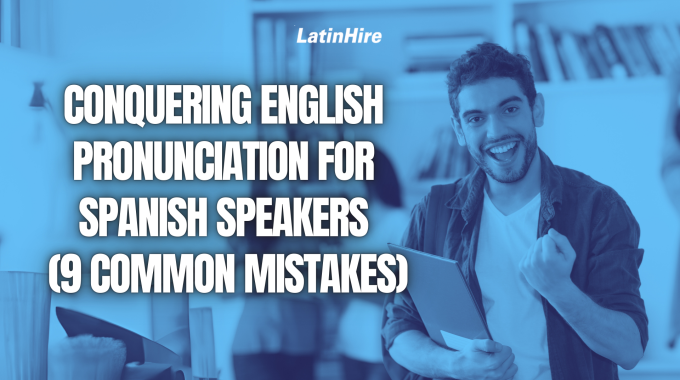Teaching English online to children is a lot more hands-on than teaching adults. It requires…

Conquering English Pronunciation for Spanish Speakers (9 Common Mistakes)
Learning a new language is a challenging yet rewarding experience. In our increasingly globalized world, multilingualism is more valuable than ever. For many Spanish speakers, mastering English opens doors to better work opportunities, broader cultural experiences, and improved communication. However, English pronunciation presents many hurdles due to its complex sound system, many of which are completely foreign to Spanish speakers.
Here are nine common pronunciation mistakes native Spanish speakers often make when speaking English, along with tips to overcome them.
1) The “Th” Sound
English words that begin with “th,” like “think,” “thirty,” and “then” contain a sound that doesn’t exist in Spanish.
- Common mistake: Replacing the “th” sound with a “t,” “d,” or “s” sound. For example, “think” becomes “tink” or “sink,” and “that” becomes “dat.”
- Tip: To produce the “th” sound, lightly place your tongue between your teeth, pull your tongue back gently, and blow air out. Practice saying these words: think, thin, thank, bath, birthday, brother.

2) Short vs. Long Vowel Confusion
Spanish vowels tend to be clean and consistent, but English vowels, not so much. English vowels vary significantly in length and quality.
- Common mistake: Mixing up short and long vowel sounds. For example, “ship” vs. “sheep,” “bit” vs. “beat,” “full” vs. “fool.”
- Tip: Practice listening for the subtle differences in vowel sounds and exaggerate them when you speak. Pay attention to the length and mouth position. Practice these words: ship/sheep, bit/beat, full/fool, tap/tape, tub/tube, hug/huge, slide/slid, quit/quite.
3) Adding an “E” Sound Before “S”
Spanish words rarely begin with “s” followed by consonants.
- Common mistake: Adding an extra “e” vowel sound at the beginning. For example, “school” becomes “eschool” and “Spain” becomes “Espain.”
- Tip: Practice these tricky words slowly, focusing on the initial consonant cluster. Record yourself to see if you catch the extra sound and then practice to eliminate it.

4) Silent Letters Get Spoken
Spanish is a largely phonetic language, so all letters have consistent pronunciation (“j” is pronounced as “h”) or consistent silence (like the silent “h”). English, however, often throws in silent letters for no apparent reason.
- Common mistake: Pronouncing silent letters, like the “b” in “lamb,” the “k” in “know,” and “h” in “honest.”
- Tip: Learn and memorize common silent letter patterns in English. Reading out loud can help you develop an intuition for silent letters.
5) Confusing the /b/ and /v/ Sounds
Spanish doesn’t differentiate much between /b/ and /v/, however in English, they’re very distinct sounds.
- Common mistake: Confusing the /b/ and /v/ sounds, like saying “berry” when you mean “very,” or “ban” when you mean “van.”
- Tip: For the /v/ sound, touch the bottom lip to your top teeth and for the /b/ sound, press your lips together.
6) Word Stress and Intonation
English word stress is less predictable than Spanish, and stress can completely change a word’s meaning.
- Common mistake: Misplacing stress. “REcord” is a noun while “reCORD” is a verb. “PREsent” is a noun while “preSENT” is a verb.
- Tip: Pay close attention to how native speakers emphasize different syllables. Mimic their rhythm and intonation. Online dictionaries often show stress placement.
7) Dropping Final Consonants
In fast Spanish speech, final consonants may be softened or dropped, but in English, dropping final consonants can confuse listeners.
- Common mistake: Saying “I wan” instead of “I want,” or “goin” instead of “going” (especially in formal settings).
- Tip: Consciously pronounce the ending consonants when you practice speaking (except for those words that have a silent final consonant, like “lamb”). Overdoing it a little at first can help build the habit.

8) Difficulty with Consonant Clusters
English has many consonant clusters (groups of consonants) that are challenging for Spanish speakers.
- Common mistake: Simplifying or omitting consonants in clusters like “str” in “street,” “spl” in “splash,” and “thr” in “through.”
- Tip: Break down the clusters into individual sounds and practice them slowly. Gradually increase the speed. Tongue twisters can be very helpful to practice consonant clusters.
9) The “H” Sound
The English “h” sound is pronounced (in an aspirated manner with a puff of air), unlike the silent “h” in Spanish.
- Common mistake: Omitting the “h” sound in words like “house,” “happy,” and “hotel.”
- Tip: Practice producing a strong “h” sound by exhaling as you say the word. Place your hand in front of your mouth to feel the air.
We hope this article will help you master English pronunciation as a Spanish speaker. Are there any other pronunciation nuances you find challenging? Share them in the comments below!



